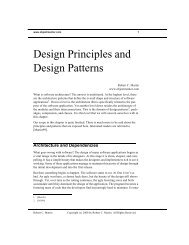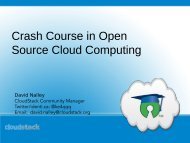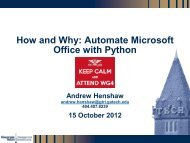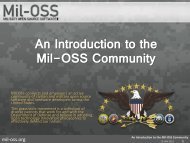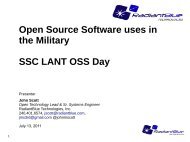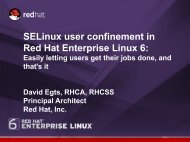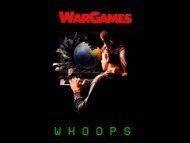GStreamer for Video Processing Applications - Mil-OSS
GStreamer for Video Processing Applications - Mil-OSS
GStreamer for Video Processing Applications - Mil-OSS
Create successful ePaper yourself
Turn your PDF publications into a flip-book with our unique Google optimized e-Paper software.
<strong>GStreamer</strong> <strong>for</strong> <strong>Video</strong><strong>Processing</strong><strong>Applications</strong><strong>Mil</strong>-<strong>OSS</strong> WG3, August 30, 2011Stephen D. Burks, Joshua M. DoeUS Army RDECOM CERDEC NVESDoss@nvl.army.mil(Distribution A: Public Release Unlimited)
Outline• Overview of <strong>GStreamer</strong>• Image capture• Real-time image processing• Image quality analysis
What is <strong>GStreamer</strong>?• Graph based multimedia framework (~Microsoft DirectShow)• Open source – LGPL license• Can be used in proprietary products• Cross-plat<strong>for</strong>m• Linux, Windows, Mac OS X, Android, Symbian, …• Multiple languages• C library, many bindings (C++, Python, Java, Perl,…)http://www.gstreamer.net/
<strong>GStreamer</strong>:Pervasive Technology• Media players, video editors, VOIP and video calls, musiceditors/composers, camera capture, transcoding, …• Texas Instruments, Nokia, Intel, Motorola, Freescale,Tandberg (Cisco), …• GNOME, Totem, Rythmbox, Banshee, Songbird, PiTiVi, …
<strong>GStreamer</strong> Basics• Element• Source – file, test pattern generator, network• <strong>Processing</strong> element – encoder/decoder, trans<strong>for</strong>m,colorspace• Sink – file, display, network• Plug-in – collection of elements• Bin / pipeline – connected set of elements
<strong>GStreamer</strong> Overview• Capabilities: describes input/output data• Example: “video/x-raw-gray, bpp=16, depth=16,endianness=BIG_ENDIAN, width=640, height=480”• video/x-raw-rgb, video/x-raw-bayer, image/tiff, audio/x-raw-int, etc.• Properties• Communication• Buffers – sample of audio, frame of video• Events/Messages/Queries – communication between elements and/or application
<strong>GStreamer</strong> Strengths• Modularized processing• Can combine elements in arbitrary ways <strong>for</strong> rapid prototyping• Already developed data processing steps aid in rapid development• Single stream of data can be displayed, written to file, processedmultiple times, or any combination of them.• Quick testing of pipeline through command line• Automatic negotiation of capabilities• Handles time synchronization• Automatic plug-in discovery• Agnostic to data type• Arbitrary capabilities
Common <strong>GStreamer</strong> Elements• filesrc/filesink – stream data from/to a file• multifilesrc/multifilesink – stream data from/to multiple files• tee – duplicate a stream• queue – FIFO buffer• videotestsrc – test pattern generator• autovideosink - display• videoconvert – convert between colorspaces/<strong>for</strong>mats
Making a <strong>GStreamer</strong> plug-in• Most written in C, but steep learning curve• Need to learn GLib, GObject (object oriented C)• Lots of boilerplate code• Rapid prototyping• Can be written in Python• NVESD engineers developed MATLAB wrapper
Visual <strong>Processing</strong> andExploitation Framework (VPEF)• Focus on the enterprise and cloud computing• VBench application <strong>for</strong> graphical creation ofpipelines
Image Capture:Overview• Want multi-spectral imagery that is spatially and temporallyregistered• Researchers also like to have multiple variants of a certain type ofsensor, such as a smaller and larger pixel pitch• Some data collections have as many as 10 sensors going into asingle capture computer• Need a means to display and save all this imagery without any loss
Image Capture:Vendor Card Support• Currently have support <strong>for</strong> the following capture cards– National Instruments IMAQ– Euresys– Blackmagick DeckLink• We are adding support <strong>for</strong> the following capture cards– Active Silicon– Coreco– BitFlow– Matrox– Foresight Imaging
Image Capture:Metadata and Ground Truth• In order to simplify data collections, it is beneficial to knowall of the following:– Target, location, range, aspect– Weather, atmospheric transmission– Time of collection, sensor mode, sensor parameters• There is no NVESD standard <strong>for</strong> this in<strong>for</strong>mation, so weare looking into MISB/SMPTE (MXF)• This in<strong>for</strong>mation will be embedded with the video
Image Capture:Cost Savings of <strong>GStreamer</strong> Approach• Software– Capture software from two major vendors cost 5K and 10K per license– Captured data usually has to be re-processed once collected• Hardware– Since <strong>GStreamer</strong> will support multiple vendors, users can choose lessexpensive options– Example: Need 4 RS-170 signals captured simultaneously. 4 NI-1410cards cost approximately 4K, while one Euresys Picolo card costs 0.6K.They will give identical imagery in <strong>GStreamer</strong>.• Personnel– Less time re-processing imagery– Fewer individuals needed manning computers– Less need <strong>for</strong> data-loggers since that data can be saved with imagery
Real-Time Image <strong>Processing</strong>• Most data is collected at one site, processed at another site, and thenanalyzed using additional software• It would be in our best interests to combine all of these steps so long as:• Data is not lost due to processing or analysis• The interface is simple• It is simple to add and modify processing or analysis steps
Real-Time Image <strong>Processing</strong>:Image FusionWaveband AFusionProcessWaveband B
Real Time Image <strong>Processing</strong>:Sample Graphical Pipelines• Image capture pipeline• Timing negotiated by <strong>GStreamer</strong>• This pipeline has 2 video inputs, 4 processingelements, 3 video outputs, and 3 file outputs
Real-Time Image <strong>Processing</strong>:Image Registration• Affine trans<strong>for</strong>mations (shift, scale, rotate)• Once we find algorithms <strong>for</strong> more advancedimage registration, we will add them as elements
Real-Time Image <strong>Processing</strong>:Cost Savings of <strong>GStreamer</strong> Approach• Rapid Prototyping– Can add, change, and remove <strong>GStreamer</strong> elements with ease– Image quality can be strongly affected by some image processingelements, while others will be benign to image quality– Faster time from prototype to engineering test unit• Re-Use of Elements– Most image processing tasks are now standardized, so there is noneed to re-code them multiple times.– It is the relative weights of these elements that make them unique <strong>for</strong> aparticular program.
Image Quality Analysis:Introduction• To complete the task of determining what is the best image process,one needs to “score” imagery based upon certain metrics.winner• The Image quality tasks could be added as discrete elements into the pipeline <strong>for</strong>real time scoring of imagery• If a certain image quality metric is determined to correlate well to an observer task(like navigation or identification), then a user can make image processing changesto raise that score <strong>for</strong> a particular task.
Image Quality Analysis:Objective Measurements• Want to have ability to do “on the fly” measurements ofobjective image quality measurements– Resolution (MTF)– Noise (3D Noise)– Responsivity (SITF)• These measurements can determine if your sensor isfocused properly and if its electronics are workingproperlyMTFCyc/mrad
Integration with DoD OTD• Plan to put all appropriate code on Software.Forge.mil• Migration of some code to public <strong>GStreamer</strong> repositorypending document reviews– Bug fixes/minor enhancements to existing plug-ins– Commercial hardware support– Simple elements (non-proprietary technology)• Interested in collaboration with other militaryorganizations focused on image processing
Demonstration



